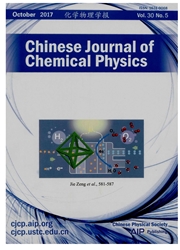

 中文摘要:
中文摘要:
The dynamics of photostopping iodine atoms from electrically oriented ICl molecules was numerically studied based on their orientational probability distribution functions. Velocity distributions of the iodine atoms and their production rates were investigated for orienting electrical fields of various intensities. For the ICl precursor beams with an initial rotational temperature of~1 K, the production of the iodine atoms near zero speed will be improved by about~5 times when an orienting electrical field of~200 k V/cm is present. A production rate of~0.5‰ is obtained for photostopped iodine atoms with speeds less than 10 m/s, which are suitable for magnetic trapping. The electrical orientation of ICl precursors and magnetic trapping of photostopped iodine atoms in situ can be conveniently realized with a pair of charged ring magnets. With the maximal value of the trapping field being~0.28 T, the largest trapping speed is~7.0 m/s for the iodine atom.
 英文摘要:
英文摘要:
The dynamics of photostopping iodine atoms from electrically oriented ICI molecules was numerically studied based on their orientational probability distribution functions. Velocity distributions of the iodine atoms and their production rates were investigated for orienting electrical fields of various intensities. For the IC1 precursor beams with an initial rotational temperature of ~ 1 K, the production of the iodine atoms near zero speed will be improved by about ~ 5 times when an orienting electrical field of ~ 200 kV/cm is present. A production rate of ~ 0.5%0 is obtained for photostopped iodine atoms with speeds less than 10 m/s, which are suitable for magnetic trapping. The electrical orientation of IC1 precursors and magnetic trapping of photostopped iodine atoms in situ can be conveniently realized with a pair of charged ring magnets. With the maximal value of the trapping field being ~ 0.28 T, the largest trapping speed is ~ 7.0 m/s for the iodine atom.
 同期刊论文项目
同期刊论文项目
 同项目期刊论文
同项目期刊论文
 Production of CH (A2△) by multi-photon dissociation of (CH3)2CO, CH3NO2, CH2Br2, and CHBr3 at 213 nm
Production of CH (A2△) by multi-photon dissociation of (CH3)2CO, CH3NO2, CH2Br2, and CHBr3 at 213 nm 期刊信息
期刊信息
